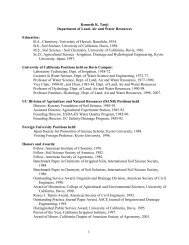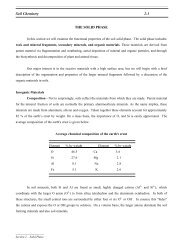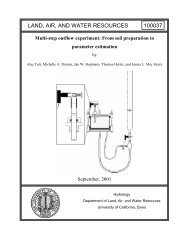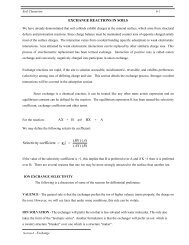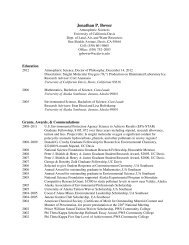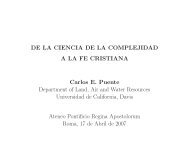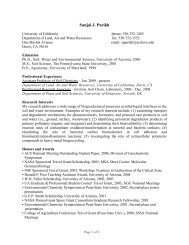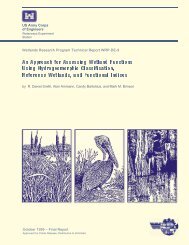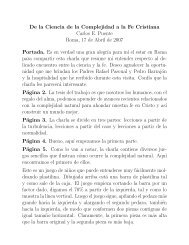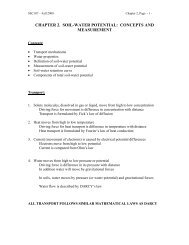Chapter 8 - Soil Temperature - LAWR
Chapter 8 - Soil Temperature - LAWR
Chapter 8 - Soil Temperature - LAWR
You also want an ePaper? Increase the reach of your titles
YUMPU automatically turns print PDFs into web optimized ePapers that Google loves.
SSC 107, Fall 2001 – <strong>Chapter</strong> 8 Page 8-1<br />
<strong>Chapter</strong> 8 - <strong>Soil</strong> <strong>Temperature</strong><br />
• Factors affecting soil temperature<br />
• Heat transfer processes<br />
• Thermal conductivity and diffusivity<br />
• Measurement of temperature<br />
• Diurnal and annual cycles<br />
• Heat capacity<br />
• Heat flow<br />
• Determining K T in field<br />
• Simultaneous transport of water and heat<br />
------------------------------------------------<br />
<strong>Temperature</strong> affects several processes<br />
• assimilation<br />
• respiration<br />
• transpiration<br />
• chemical reactions in soil and plants<br />
• diffusion of gases and solutes<br />
• water flow in soil<br />
• translocation<br />
• microbial activity<br />
• availability of water to plants
SSC 107, Fall 2001 – <strong>Chapter</strong> 8 Page 8-2<br />
Factors that influence temperature<br />
-------------------<br />
of surface soil<br />
-------------------<br />
- radiation from sun<br />
- slope of land<br />
- water content of soil<br />
- vegetative cover<br />
- albedo<br />
-------------------<br />
of subsurface soil<br />
-------------------<br />
- heat flux from surface<br />
- water content<br />
- bulk density<br />
- heat capacity of soil<br />
Radiation<br />
See Fig. 5.1, 5.2, 5.3, 5.4, 5.5, 5.6, and 5.7 in the book (Jury et al., 1991)<br />
• Radiation from sun is mostly short wave.<br />
• Earth absorbs short wave - some reflected<br />
• Earth radiates energy nearly like a black body (primarily long wave)
SSC 107, Fall 2001 – <strong>Chapter</strong> 8 Page 8-3<br />
• H 2 O vapor, CO 2 , N 2 O, CH 4 , synthetic industrial gases, and dust absorb long wave
SSC 107, Fall 2001 – <strong>Chapter</strong> 8 Page 8-4<br />
Heat Transfer Processes<br />
1. Radiative<br />
- Any surface radiates energy<br />
- What is mostly felt as heat coming from fireplace<br />
- Stefan's Law<br />
Radiation from blackbody<br />
∑ = ε σ T 4<br />
∑ -<br />
cal<br />
- Energy flux, integrated over all wavelengths<br />
2<br />
cm min<br />
ε = 1 for blackbody<br />
ε < 1 for other bodies<br />
σ = 8x10 -11 cal cm min -1 ºK -4<br />
T - ºK<br />
2. Convection<br />
- Hot air rises causing mixing and transport<br />
3. Conduction<br />
- Net molecular exchange of kinetic energy which takes place<br />
from more energetic molecules (hot regions) to less<br />
energetic molecules (cool regions)<br />
Within soil, radiative and convection are very small in relation to conduction
SSC 107, Fall 2001 – <strong>Chapter</strong> 8 Page 8-5<br />
Measurement of <strong>Temperature</strong><br />
- Glass thermometers<br />
- high heat capacity<br />
- may conduct heat along thermometer<br />
- Thermocouples & Thermistors<br />
- response good<br />
- small size<br />
- Radiation Thermometer<br />
- measures surface temperature<br />
- measures infrared<br />
Diurnal and annual cycles<br />
See 5.14 and 5.15 in the textbook (Jury et al., 1991).<br />
• <strong>Soil</strong> heats up during day, cools at night<br />
• Diurnal variations damped with depth<br />
• Peak shifts
SSC 107, Fall 2001 – <strong>Chapter</strong> 8 Page 8-6<br />
Heat Capacity<br />
∆Q<br />
o<br />
Heat capacity = (cal / K)<br />
∆T<br />
∆Q is quantity of heat<br />
∆T is associated T change<br />
Heat capacity is dependent upon size of the system. Heat capacity per unit mass is<br />
∆ Q<br />
c =<br />
m∆t<br />
cal<br />
g°<br />
K<br />
c is called specific heat<br />
- independent of system size<br />
<strong>Soil</strong><br />
Minerals H 2 O Humus<br />
c 0.2 1.0 0.5<br />
cal<br />
cal<br />
cal<br />
g° K<br />
g° K<br />
g°<br />
K
SSC 107, Fall 2001 – <strong>Chapter</strong> 8 Page 8-7<br />
Volumetric heat capacity<br />
Csoil = S X i ρ i c i<br />
∆Q<br />
=<br />
V∆T<br />
cal<br />
cm ° K<br />
Csoil<br />
3<br />
X i - volume fraction of particular soil constituent<br />
Csoil = X m ρ m c m + X o ρ o c o + X w ρ w c w + X a ρ a c a<br />
- X m , X o , X w , & X a are volume fractions of mineral matter, organic<br />
matter, water, & air<br />
- ρ are respective densities<br />
- c are respective specific heats<br />
ρ<br />
ρw<br />
therefore ρ<br />
1000<br />
a<br />
=<br />
a<br />
≈ 0<br />
Csoil = X m ρ m c m + X o ρ o c o + X w ρ w c w<br />
ρ m = 2.6 g/cm 3<br />
ρ o = 1.3 g/cm 3<br />
ρ w = 1.0 g/cm 3<br />
Csoil = X m (2.6) (0.2) + X o (1.3) (0.5) + X w (1) (1)<br />
= 0.52 X m + 0.65 X o + X w<br />
Volumetric heat capacity has units of cal cm -3 soil °K -1<br />
Since Xw is just volumetric water content, X w = θv .<br />
The equation using slightly different values for ? and c given by Jury et al. (1991) is<br />
C<br />
soil<br />
= 0.46 (1 - φ - X o)<br />
+ 0.6 X<br />
o<br />
+ θ<br />
v<br />
In California soils the X o ≈ 1%, so this term has little influence.
SSC 107, Fall 2001 – <strong>Chapter</strong> 8 Page 8-8<br />
In all problems, assume X o =0 if not specified.
SSC 107, Fall 2001 – <strong>Chapter</strong> 8 Page 8-9<br />
Steady State<br />
J<br />
H<br />
= - λ<br />
e<br />
d T<br />
d z<br />
Heat Flow<br />
= heat flux<br />
density<br />
cal<br />
cm sec<br />
JH<br />
2<br />
λe - effective thermal conductivity<br />
cal<br />
cm soil sec ° K<br />
T - temperature °K<br />
z - distance (cm)<br />
Transient State<br />
∂T<br />
- ∂ J<br />
C =<br />
∂t<br />
∂z<br />
H<br />
∂T<br />
∂ ⎡<br />
C = ⎢λ<br />
∂t<br />
∂z<br />
⎣<br />
e<br />
∂T<br />
⎤<br />
∂z<br />
⎥<br />
⎦<br />
If λe constant with z<br />
C<br />
∂T<br />
= λ<br />
∂t<br />
e<br />
2<br />
∂ T<br />
2<br />
∂z<br />
∂T<br />
= K<br />
∂t<br />
T<br />
2<br />
∂ T<br />
2<br />
∂z<br />
K<br />
T<br />
λe<br />
=<br />
C<br />
K T - <strong>Soil</strong> thermal diffusivity
SSC 107, Fall 2001 – <strong>Chapter</strong> 8 Page 8-10<br />
λ e<br />
C K T<br />
θ θ θ<br />
Also, see Fig. 5.10 and 5.11 in Jury et al., 1991 book.<br />
Thermal conductivities for several materials<br />
dry soil 1.5 x 10 -3 cal<br />
cm sec ° K<br />
H 2 O 1.4 x 10 -3 "<br />
air 6 x 10 -5 "<br />
copper 0.918 "<br />
steel 0.108 "<br />
cardboard 5 x 10 -4 "<br />
glass 1.7 x 10 -3 "<br />
quartz 26.3 x 10 -3 "<br />
clay minerals 8.7 x 10 -3 "
SSC 107, Fall 2001 – <strong>Chapter</strong> 8 Page 8-11<br />
Determining K T in field<br />
T<br />
T<br />
A0<br />
12 hrs 24 hrs<br />
time<br />
T<br />
T(o,t) = T + A o sin ωt<br />
T(o,t) - <strong>Temperature</strong> at z=o (soil surface)<br />
T - Average daily temperature at soil surface<br />
A o - Amplitude of surface temperature fluctuation<br />
ω - radial frequency<br />
2 π<br />
ω = τ - period = 86,400 s (=24 hours)<br />
τ<br />
2 radians<br />
ω = π<br />
86,400 s<br />
Also assume that T (∞,t) = T<br />
T assumed to be same at all depths<br />
∂T<br />
= K<br />
∂t<br />
2<br />
∂ T<br />
2<br />
z<br />
T ∂<br />
Solution with above conditions is
SSC 107, Fall 2001 – <strong>Chapter</strong> 8 Page 8-12<br />
T(z,<br />
t) = T + A<br />
o<br />
e<br />
-z/d<br />
[sin ( ω t -<br />
z<br />
)]<br />
d<br />
d is "damping depth" at which the T amplitude decreases to 1/e of A o<br />
d is usually 20-30 cm for diurnal temperature fluctuations<br />
d =<br />
2K T<br />
ω<br />
¯ Calculate d for the annual wave using t for one year.<br />
Amplitude Equation<br />
amplitude at z=o is A o<br />
amplitude at z=z 1 is A 1 = A o exp (-z 1 /d)<br />
amplitude at z=z 2 is A 2 = A o exp (-z 2 /d)<br />
A1<br />
exp(-z1/d)<br />
= = exp [(z<br />
A2<br />
exp(-z2/d)<br />
z2<br />
- z1<br />
ln( A1<br />
/ A 2)<br />
=<br />
d<br />
z2<br />
- z1<br />
d =<br />
ln( A1<br />
/ A 2)<br />
2<br />
- z<br />
1<br />
)/d]<br />
2K<br />
T ω<br />
z<br />
2<br />
- z1<br />
=<br />
ln( A 1/<br />
A 2)<br />
K<br />
T<br />
ω ⎡ z<br />
2<br />
- z1<br />
⎤<br />
=<br />
2<br />
⎢ ⎥<br />
⎣ln(<br />
A1<br />
/ A 2)<br />
⎦<br />
2
SSC 107, Fall 2001 – <strong>Chapter</strong> 8 Page 8-13<br />
Determine A 1 at z 1 and A 2 at z 2 . Calculate K T .<br />
Phase Equation<br />
T(z,<br />
t) = T + A<br />
o<br />
e<br />
-z/d<br />
⎡ z ⎤<br />
⎢sin ( ω t - ) ⎥<br />
⎣ d ⎦<br />
When T is maximum at each depth, the sin ( ) must be maximum.<br />
The sin ( ) is maximum when the ( ) = 2<br />
π , sin 2<br />
π = 1 .<br />
∴ω<br />
ω<br />
z π<br />
- =<br />
d 2<br />
1<br />
t1<br />
z π<br />
- =<br />
d 2<br />
2<br />
t 2<br />
and<br />
Thus, can equate the 2 terms<br />
z1<br />
z2<br />
ω t1 - = ωt<br />
2<br />
-<br />
d d<br />
- z1 z2<br />
+ = ω t2 - ωt 1<br />
d<br />
d<br />
1<br />
(z<br />
2<br />
- z1)<br />
= ω(t<br />
d<br />
2<br />
- t<br />
1<br />
)<br />
1 ⎡z<br />
d = ⎢<br />
⎣ t<br />
- z<br />
2 1<br />
ω<br />
2<br />
- t1<br />
⎤<br />
⎥<br />
⎦
SSC 107, Fall 2001 – <strong>Chapter</strong> 8 Page 8-14<br />
2K<br />
T<br />
1 ⎡z<br />
ω =<br />
ω<br />
⎢<br />
⎣ t<br />
2<br />
2<br />
- z<br />
- t<br />
1<br />
⎤<br />
⎥<br />
⎦<br />
1<br />
2 K<br />
1 ⎡ z2<br />
- z<br />
=<br />
2 ⎢<br />
ω ⎣ t<br />
2<br />
- t<br />
T<br />
1<br />
ω<br />
1<br />
2<br />
⎤<br />
⎥<br />
⎦<br />
K<br />
T<br />
1<br />
=<br />
2<br />
⎡z<br />
⎢<br />
⎣ t<br />
- z<br />
2 1<br />
ω<br />
2<br />
- t1<br />
Thus, K T can be determined by measuring the time at which the maximum temperature is observed at two<br />
depths. K T is the diffusivity of the soil between two depths.<br />
2<br />
⎤<br />
⎥<br />
⎦
SSC 107, Fall 2001 – <strong>Chapter</strong> 8 Page 8-15<br />
Simultaneous Transport of Water and Heat<br />
• <strong>Temperature</strong> gradients affect soil-water potential which induces both liquid and vapor movement.<br />
• <strong>Soil</strong>-water potential gradients move water, which consequently carries heat.<br />
• Combined transport generally ignored in very wet systems and in very dry systems. Temp. gradient<br />
effect on water flow small in relation to soil-water potential grad. in wet range. Little water is moved<br />
in very dry range.<br />
• Two approaches<br />
• Mechanistic<br />
• Irreversible thermodynamics<br />
Mechanistic<br />
For water<br />
∂ θ<br />
∂t<br />
v<br />
∂ ⎛<br />
= ⎜ D<br />
∂z<br />
⎝<br />
T<br />
∂T<br />
⎞ ∂ ⎛<br />
⎟ + ⎜D<br />
∂z<br />
⎠ ∂z<br />
⎝<br />
w<br />
∂ θv<br />
⎞ ∂K<br />
⎟ -<br />
∂z<br />
⎠ ∂z<br />
For heat<br />
∂T<br />
∂ ⎛<br />
C = ⎜λ<br />
∂t<br />
∂z<br />
⎝<br />
e<br />
∂T<br />
⎞ ∂ ⎛<br />
⎟ - L ⎜D<br />
∂z<br />
⎠ ∂z<br />
⎝<br />
w, v<br />
∂θ ⎞<br />
⎟<br />
∂z<br />
⎠<br />
D T - water diffusivity under temperature gradient<br />
D w - water diffusivity under water potential gradient<br />
L - Latent heat of vaporization<br />
D w,v - Diffusivity for heat conveyed by water movement<br />
Problems with mechanistic approach<br />
- Difficult to measure or calculate diffusivities<br />
- Two flow mechanisms are not strictly additive since they interact
SSC 107, Fall 2001 – <strong>Chapter</strong> 8 Page 8-16<br />
Irreversible thermodynamics<br />
For water<br />
1 dP 1<br />
qw<br />
= - Lww<br />
- Lwh<br />
2<br />
T dz T<br />
dT<br />
dz<br />
For heat<br />
1 dP 1<br />
qh<br />
= - Lhw<br />
- Lhh<br />
2<br />
T dz T<br />
dT<br />
dz<br />
P - <strong>Soil</strong>-water potential<br />
L i,j - Coefficients which are unknown functions of P and T<br />
Makes no assumptions about mechanisms
SSC 107, Fall 2001 – <strong>Chapter</strong> 8 Page 8-17<br />
Figures on simultaneous transport of water and heat follow:





